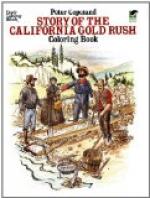This great yellow cat is both savage and cowardly, and he has been known to follow a man walking through the woods, all day, yet he sneaked out of sight at every loud call the man gave. He chases deer and gets many small and helpless fawns, hunters say.
Fur-hunting was once a profitable business for the Indians, who were clothed in bear and panther skins when the first white men came to California, and had many furs to trade or sell. The Indians trapped otters, beavers, and minks, and the squaws tanned the deer-hides to make buckskin shirts or leggings. Hunters and trappers still bring in these wild animals’ furry coats after trips to the high mountains or untravelled woods, where the shy creatures try to live and be safe from their enemies.
In early days herds of a very large deer, called elk, fed on the wild oats and grass. These elk had wide, branching horns measuring three or four feet from tip to tip. Only a few of them now survive in the redwood forests in the northern counties. There were plenty of them once where San Francisco now stands. Dana in his book called “Two Years Before the Mast,” tells us that when his ship dropped anchor off the little village of Yerba Buena about sixty-seven years ago, he saw hundreds of red deer and elk with their branching antlers. They were running about on the hills, or standing still to look at the ship until the noise frightened them off. At that time the whole country was covered with thick trees and bushes where the wolf and coyote prowled, and the grizzly bear’s track was seen everywhere.
[Illustration: CALIFORNIA RED DEER. From a photograph by George V. Robinson.]
There are plenty of deer in the redwoods now, and in the high Sierras are black-tailed and large mule-deer. In the woods round Mount Tamalpais timid red deer live, too. In winter, when it is cold and snowy in the northern counties of our state, these deer often come into the farmer’s barnyard to nibble at the hay.
There are still left in the mountains among the pines and snowy cliffs many mountain-sheep. These curious big-horned animals resemble both the elk and the sheep, and it is said they can jump from a high rock and land far below on their feet or heavy, twisted horns without being hurt in the least.
Of all the great herds of graceful, fast-running antelope, once the most plentiful of our wild animals, only a very few can now be found on the eastern slopes of the Sierras.
But Master Coyote, who might well be spared, so cruel and cowardly is he, still sneaks up and down the whole state, and his quick sharp bark gives notice that the rascal is ready to steal a chicken or a lamb if it is not protected. With his bushy tail and large head he is half fox and half wolf in appearance, and mean enough in habits to be both. He can outrun a dog and even a deer, and though he catches jack-rabbits and the Molly Cottontail usually for food, he would help his brother, the wolf, to kill a poor harmless sheep.




